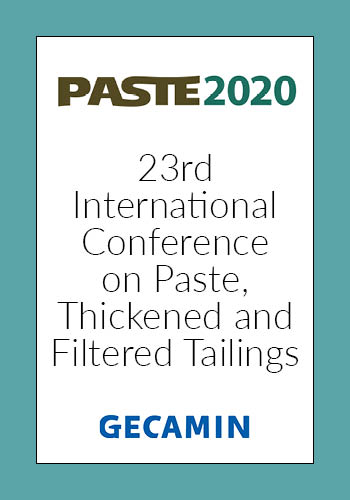The impact of high salinity and seawater on aggregate structures in clay tailings flocculation

|
Authors: Jeldres, R; Yang, T; Costine, A; Fawell, P; Bellwood, J |
DOI https://doi.org/10.36487/ACG_repo/2052_24
Cite As:
Jeldres, R, Yang, T, Costine, A, Fawell, P & Bellwood, J 2020, 'The impact of high salinity and seawater on aggregate structures in clay tailings flocculation', in H Quelopana (ed.), Paste 2020: 23rd International Conference on Paste, Thickened and Filtered Tailings, Gecamin Publications, Santiago, https://doi.org/10.36487/ACG_repo/2052_24
Abstract:
The use of seawater, hypersaline or other low-quality water supplies in mineral processing operations has strong benefits in places like Chile and Australia, not just economically but in ensuring social license to operate. Despite this commercial application, the effect of dissolved salts on tailings flocculation is not yet fully understood. This partly stems from the operator-dependence that plagues normal cylinder testing and the tendency in some previous literature studies to make flocculant activity comparisons under a narrow range of conditions (single dosage, solids concentration and/or fixed mixing). Six acrylamide/acrylate copolymers with the same anionicity (30%) but different molecular weights, were evaluated in the flocculation of standard kaolin slurries prepared in seawater or solutions containing selected cations at various concentrations. Settling rate-dosage response curves were collected for these polymers, combining continuous Couette flocculation with real-time aggregate sizing and off-line determination of individual aggregate settling rate vs. size, from which their densities could be derived. Shifts in the dosage response curves under different conditions reflected changes in both the aggregate size and density. From the large body of flocculation data produced under tightly controlled conditions, new insights were gained on how salinity alters mixing requirements for aggregation, responses to molecular weight and aggregate structure. Some salt addition was beneficial in producing an initial low level of aggregation of fines that reduced the effective surface area of the suspension and subsequent flocculant dosage requirements. At high ionic strength, a reduction in flocculant bridging capacity due to chain coiling resulted in open, low density aggregate structures, which substantially increased the flocculant demand to achieve a target settling rate. The potential impact should be a much more robust basis for flocculant selection, which is currently very much trial-and-error.
References:
Arinaitwe, E., Pawlik, M. (2013) ‘A role of flocculant chain flexibility in flocculation of fine quartz. Part I. Intrinsic viscosities of polyacrylamide-based flocculants’, Int. J. Miner. Process. 124, 50-57.
Costine, A., Cox, J., Travaglini, S., Lubansky, A., Fawell, P., Misslitz, H. (2018) ‘Variations in the molecular weight response of anionic polyacrylamides under different flocculation conditions’, Chem. Eng. Sci., 176, 127-138.
Farrow, J.B., Swift, J.D. (1996) ‘A new procedure for assessing the performance of flocculants’, Int. J. Miner. Process., 46, 263–275.
Farrow, J.B., Warren, L.J. (1989) ‘The measurement of floc density-floc size distributions’, Flocculation and dewatering. Engineering Foundation, New York, USA.
Fawell, P.D., Costine, A.D., Grabsch, A.F. (2015) ‘Why small-scale testing of reagents goes wrong’, Proceedings of the 18th International Seminar on Paste and Thickened Tailings. Australian Centre for Geomechanics, Cairns, Australia, pp. 153-166.
Happel, J., Brenner, H. (1973) Low Reynolds Number Hydrodynamics. Noordhoff International Publishing, Leyden, Netherlands.
Huber, K. (1993). ‘Calcium-induced shrinking of polyacrylate chains in aqueous solution’, J. Phys. Chem., 97, 9825-9830.
Jeldres, R.I., Toledo, P.G., Concha, F., Stickland, A.D., Usher, S.P., Scales, P.J. (2014) ‘Impact of seawater salts on the viscoelastic behavior of flocculated mineral suspensions’, Colloids Surf. A Physicochem. Eng. Asp. 461, 295-302.
Peng, F.F., Di, P.K. (1994) ‘Effect of multivalent salts calcium and aluminum on the flocculation of kaolin suspension with anionic polyacrylamide’, J. Colloid Interface Sci. 164, 229-237.
Witham, M.I., Grabsch, A.F., Owen, A.T., Fawell, P.D. (2012) ‘The effect of cations on the activity of anionic polyacrylamide flocculant solutions’, Int. J. Miner. Process. 114-117, 51-62.
© Copyright 2025, Australian Centre for Geomechanics (ACG), The University of Western Australia. All rights reserved.
View copyright/legal information
Please direct any queries or error reports to repository-acg@uwa.edu.au
View copyright/legal information
Please direct any queries or error reports to repository-acg@uwa.edu.au